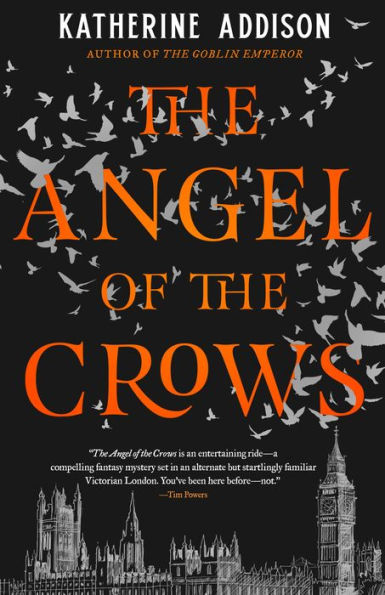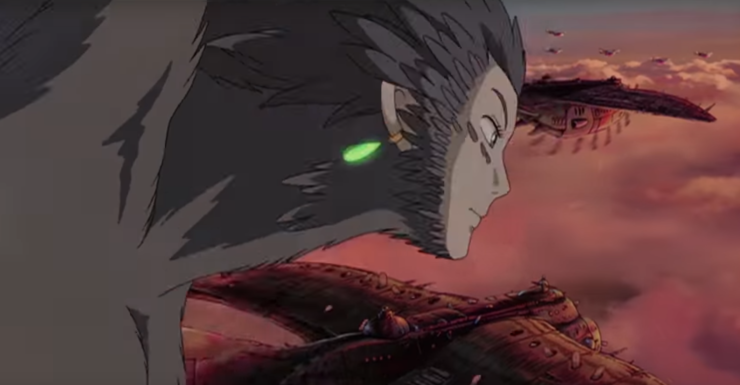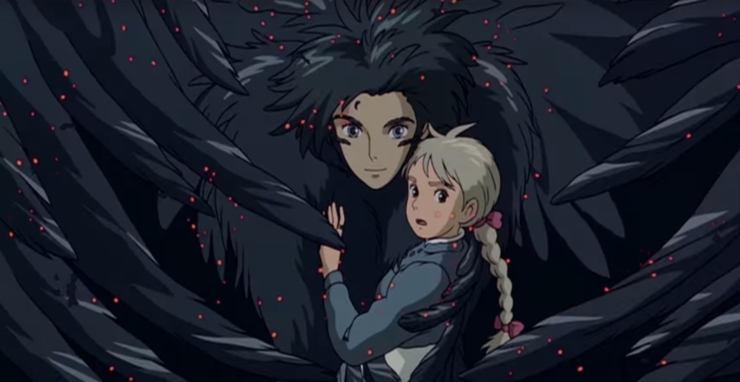We often see Asian stories adapted for a Western, English-speaking market, but Howl’s Moving Castle is one of the most famous cases of the reverse. Hayao Miyazaki’s 2004 film is a loose adaptation of Diana Wynne Jones’s 1986 novel, which Jones described as “rich and strange, full of the most beautiful animation,” by someone who “understood my books in a way that nobody else has ever done.” Miyazaki deeply understands the work the novel does: using popular fantasy tropes to interrogate and disprove dominant social narratives, and thus deprive them of their power.
In adapting and translating the novel to a visual medium for a different time and for a different, primarily Japanese audience, Miyazaki took a fascinating approach: he focused not on faithfully replicating each detail of the novel, but preserving its work. The novel Howl’s Moving Castle uses fairy tale tropes as a means to examine societal roles and restrictions that hold people into certain positions as well as holding them back, and the magical power of language to break people out of them. Miyazaki, who began working on Howl’s Moving Castle with “a great deal of rage” about the US invasion of Iraq, approaches a standard war plot at angles and strange intersections, using fantasy tropes to show the ridiculousness and pointlessness of war and the magical power of human affection, connection, and compassion to transform.
The novel begins by succinctly showing how fairy tale tropes inform reality “[i]n the land of Ingary, where such things as seven-league boots and cloaks of invisibility really exist.” Heroine Sophie Hatter, the eldest and most studious of her sisters, has internalized the idea that she will never have an interesting life, as anything she does is doomed to failure. Yet even in Sophie’s introduction, Jones points out the falseness of this fairy tale logic. If Sophie can never succeed in anything because of her place within her family, then it would follow that her stepmother would be evil, or that after her half-sister was born, Sophie and her younger sister would become “Ugly Sisters” when in reality, “all three girls grew up very pretty indeed.” It’s an immediate hint at the work of the story and Sophie’s particular arc: discovering the falsity of the social messages she internalized.
The anime does not present this Supposition-Proof-to-the-Contrary formula when introducing Sophie, instead relying on careful choreography of the characters across the screen to show both how the story works, and where Sophie will go. In the early part of the film, Sophie is often looking towards, or moving towards personal connections, but always separated from crowds: sitting apart from the other hatmakers while listening to their conversations; standing alone on the outside of a trolley on the way to see her sister; walking away from crowds, and, memorably, walking in the air above them with Howl. Sophie frequently walks away from the machinery of war, be it the literal machinery of battleships, soldiers on parade, or her fellow citizens discussing the cause of the war. In fact, as two background characters discuss how a missing prince has caused their country to go to war, Sophie walks away on her own adventure, foregrounding her personal journey as the more important plot, and keeping the standard fantasy war plot a bizarre and nonsensical background event that keeps threatening to pull in Sophie and Howl away from their important journeys towards personal connection.
Buy the Book


The Angel of the Crows
Howl’s origins and arc also point to the inherited social ideologies Jones and Miyazaki most wish to deconstruct and discard. In the book, Howl is really Howell Jenkins, a Welshman with a PhD in presumably literature, who discovered the multiverse and decided to be a wizard instead of taking his chances on the academic job market. In a visit to Wales, the villainous Witch of the Waste and her fire demon turn John Donne’s “Song: Go and Catch a Falling Star,” into a curse to kill him. This poem lists a number of impossible things, beginning with catching a falling star and ending with finding a true and fair woman, but is literally enacted in the land of Ingary. Howl’s curse comes upon him when he catches a falling star, Calcifer, and offers it his heart, and is only broken when he finds Sophie, a true and fair woman, whose sense of fairness, whose truthfulness, and whose ability to talk life into things breaks the curse not just on him, but the curses on all the rest of the cast. Donne’s misogynist assumption having been disproved as thoroughly as fairy tale tropes, and provokes the deeper question, “what other things have we been told are impossible, and why do we believe them?”
In the film however, Howl is just as much a part of this fantasy world as Sophie. This is, in part, due to a translation choice. The mention of Wales, John Donne, and fairy tale tropes like seven league boots would be instantly recognisable for Jones’s English-speaking, Western audience, and signal that the fictional land of the book is one that is shaped by and engages with the Western canon. Miyazaki shifts the setting to a pan-European one, with a vaguely Edwardian aesthetic— a common one for anime engaging with fantasy tropes not based in Japanese mythology or storytelling, and a more culturally specific way of signaling what kind of genre the movie is, and what kind of story the audience can expect. The black knob on the magical door therefore does not take Howl to Wales, which undergirds Jones’s point that fiction can form our reality, or our understanding of it, but to a place more typically Miyazaki: the sky. Miyazaki’s own lived experience, as someone born in 1941, whose father helped build airplanes in WWII, and who lived through the 1945 bombing of Utsunomiya, informs this particular Studio Ghibli trope. In Porco Rosso, Castle in the Air, and especially The Wind Rises (the later of which caused Japanese nationalists to accuse Miyazaki of being a traitor, or anti-Japanese), the sky is a place of wonder, freedom, and imagination that gets co-opted and corrupted into a theatre of war. Howl directly engages in this, by introducing the sky as a place of magic, wonder, and romance in his first meeting with Sophie, where he takes her on a walk through the air, and later taking the form of a strange bird-creature to keep an eye on the war… and his fellow wizards. “My own kind attacked me today,” Howl tells Calcifer, after seeing one of the first battles, where other wizards turned themselves into top-hatted flying monsters for the king (suggesting that any attempts to dress up war as respectable is a futile attempt that cannot hide its basic monstrosity) — all the while struggling himself to transform back into a human.

Howl is of this particular world, his separation from it defined purely by choices made as a child (when he catches Calcifer, unlike in the book), out of compassion and, presumably a desire for power. This new interpretation changes it from a story about other stories, one that comments on how the stories we hear—those that have been written, and those we tell ourselves—have shaped and have the power to shape our lived reality, to one about the senselessness of war and the limitations it places on our ability to experience and appreciate nature and each other. Howl’s main problem is not his own cowardice, but his difficulty in maintaining his humanity in the face of war, and the driving danger is not the Witch’s curse, but how his powers and bargain with Calcifer limit his ability to connect with others and keep him in a state of arrested emotional development. Howl’s bedroom is a glittering dragon’s den of a toy store, with cow plushies resting on his blankets: very much a child’s in taste and design. It’s telling that the only other occupant of the Castle, pre-Sophie was his very young apprentice Markl (changed from his fifteen-year-old apprentice Michael in the book): at once a statement on Howl’s lingering ties to childhood, and a suggestion that Howl is ready to move on to an adulthood where he gladly acts on his responsibilities for the well-being of others, instead of focusing on maintaining his personal power and freedom at all costs.
The different happy endings likewise posit different solutions to the different problems Jones and Miyazaki tackle. In the novel, all the curses are interwoven. By breaking one with her ability to talk life into things, Sophie can begin to break all the others. Howl, now with a heart, invokes a final fairy tale trope, telling Sophie, “I think we ought to live happily ever after.” In the usual Supposition-Proof-to-the-Contrary formula, Sophie reflects that “living happily ever after with Howl would be a good deal more eventful than any story made it sound.” Sophie gets the interesting life she always wished to have—one that was within her grasp as soon as she began to tell the world around her what it should be, rather than accepting what other people told her it was. In the anime, Sophie still breaks all the curses but through her personal connection with every member of what Howl calls their little family, rather than her witchcraft. The prince whose disappearance caused the war appears almost as an afterthought, but immediately goes off to end the war. As battleships fly home, Howl, Sophie, and the rest of their found family fly off in the opposite direction, into the sunset. The sky is no longer a place of war and strife, but a place of magic, wonder, and connection, as it originally was, and, as Miyazaki posits, as it is meant to be. A true happy ending is turning away from war, into the happy community you have constructed for yourself, and into the wonders of nature.
The essential story of Howl’s Moving Castle is one of movement away from a defensive stasis: away from stories forced on you, and the stories that trap, be they ones about who you are based on an accident of birth, or about the necessity of war for the maintenance of society. Both Jones and Miyazaki use Howl to analyze the narratives they profoundly disagree with and the magic they most trust, to reach the societies in which they lived at the time of creation. In Reflections: On the Magic of Writing, Jones writes of how the difficulties of writing fantasy with female main characters changed over the years and when she was able to make women the center of her stories, “I found the tactile sense of being female stopped bothering me—which may have been a part of the same revolution—and it was a release.” The feminism that transformed her literary genre helped transform her as well, and by 1986, when the novel was published, feminism was a recognizable public movement whose effects Jones felt personally and saw politically. Likewise, Miyazaki’s pacifism is shaped by his lived experiences in post-war Japan, and have long been a part of the fraught national dialogue on Japan’s role in WWII and how its history should be acknowledged, or how it should inform contemporary policy—and is as recognizable to his Japanese audience, as Western European feminism was to Jones’s audience. To break the curse of misogyny, speak up. To break the curse of war, only connect.
Elyse Martin is a Chinese-American Smith College graduate who lives in Washington DC with her husband and two cats. She writes reviews for Publisher’s Weekly, and her essays and humor pieces have appeared in The Toast, Electric Literature, Perspectives on History, The Bias, Entropy Magazine, and Smithsonian Magazine. She spends most of her time writing and making atrocious puns—sometimes simultaneously—and tweets @champs_elyse. She’s at work on several novels.










